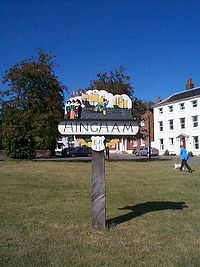- Puritan migration to New England (1620–1640)
-
This article is about Puritan migration of the 1630s. For other uses of the term Great Migration, see Great Migration (disambiguation).
The Puritan migration to New England was marked in its effects in the two decades from 1620 to 1640, after which it declined sharply for a while. The term Great Migration usually refers to the migration in this period of English settlers, primarily Puritans to Massachusetts and the warm islands of the West Indies, especially the sugar rich island of Barbados, 1630-40. They came in family groups, rather than as isolated individuals and were motivated chiefly by a quest for freedom to practice their Puritan religion.[1]
Contents
Context
For more details on this topic, see James I of England and religious issues.King James I of England made some efforts to reconcile the Puritan clergy in England, who had been alienated by the conservatism blocking reform in the Church of England. Puritans adopted Calvinism (Reformed theology) with its opposition to ritual and an emphasis on preaching, a growing sabbatarianism, and preference for a presbyterian system of church polity. They opposed religious practices in the Church that at any point came close to Roman Catholic ritual.
After Charles I of England became king (1625), this religious conflict worsened. Parliament increasingly opposed the King's authority. In 1629, Charles dissolved Parliament entirely, in an ill-fated attempt to neutralize his enemies there, who included numerous lay Puritans. With the religious and political climate so hostile and threatening, many Puritans decided to leave the country. Some of the migration was from the expatriate English communities in the Netherlands of nonconformists and Separatists who had set up churches there since the 1590s.
The 1630s
The Winthrop Fleet of 1630 of eleven ships, led by the flagship Arbella, delivered 700 passengers to the Massachusetts Bay Colony. Migration continued until Parliament was reconvened in 1640, at which point the scale dropped off sharply. In 1641, when the English Civil War began, some colonists returned to England to fight on the Puritan side, and many stayed, since Oliver Cromwell, himself an Independent, backed Parliament.[2]
From 1630 through 1640 approximately 20,000 colonists came to New England.[3] The so-called Great Migration is not so named because of sheer numbers, which were much less than the number of English citizens who emigrated to Ireland and the Caribbean during this time. The distinction drawn is that the movement of colonists to New England was not predominantly male, but of families with some education, leading relatively prosperous lives.[1] Winthrop's noted words, a City upon a Hill, refer to a vision of a new society, not just economic opportunity.
Moore (2007) estimates that 7 to 11 percent of colonists returned to England after 1640, including about a third of the clergymen.[4]
Religious freedom and tolerance
The Puritans created a deeply religious, socially tight-knit, and politically innovative culture that is still present in the modern United States. They hoped this new land would serve as a "redeemer nation." They fled England and in America attempted to create a "nation of saints": an intensely religious, thoroughly righteous community designed to be an example for all of Europe. Roger Williams, who preached religious toleration, separation of Church and State, and a complete break with the Church of England, was banished and founded Rhode Island Colony, which became a haven for other refugees from the Puritan community, such as Anne Hutchinson.[5] Quakers were brutally expelled from Massachusetts, but they were welcomed in Rhode Island.[6]
Notes
- ^ a b Betlock, Lynn. "New England's Great Migration". http://www.greatmigration.org/new_englands_great_migration.html. Retrieved 28 April 2008.
- ^ Hopley, Claire. "The Puritan Migration: Albion’s Seed Sets Sail". http://www.historynet.com/exploration/great_migrations/3035471.html?page=2&c=y. Retrieved 5 December 2008.
- ^ Ashley, Roscoe (1908). American History. New York: Macmillan. p. 52. http://books.google.com/books?id=W2kAAAAAYAAJ. Retrieved 2008-12-05.
- ^ Susan Hardman Moore, Pilgrims: New World Settlers and the Call of Home, (2007)
- ^ Edwin S. Gaustad, Roger Williams (2005).
- ^ Carla Gardina Pestana, Quakers and Baptists in Colonial Massachusetts (1991).
Further reading
- Adams, James Truslow (1921). The Founding of New England. New York: Atlantic Monthly Press. http://www.dinsdoc.com/adams-1-0a.htm.
- Anderson, Robert (1999). The Great Migration Begins: Immigrants to New England, 1620-1633. Boston: New England Historic Genealogical Society. Three volumes.
- Anderson, Virginia DeJohn. "Migrants and Motives: Religion and the Settlement of New England, 1630-1640," New England Quarterly, Vol. 58, No. 3 (Sep., 1985), pp. 339–383 in JSTOR
- Anderson, Virginia DeJohn. New England's Generation: The Great Migration and the Formation of Society and Culture in the Seventeenth Century (1991) excerpt and text search
- Bailyn, Bernard. The Peopling of British North America: An Introduction (1988) excerpt and text search
- Breen Timothy H., and Stephen Foster. "Moving to the New World: The Character of Early Massachusetts Migration," William & Mary Quarterly 30 (1973): 189-222 in JSTOR
- Cressy, David. Coming Over: Migration and Communication between England and New England in the Seventeenth Century (1987),
- Dunn, Richard S. Puritans and Yankees: The Winthrop Dynasty of New England, 1630-1717 (1962).
- Fischer, David Hackett. Albion's Seed: Four British Folkways in America (1989), comprehensive look at major ethnic groups excerpt and text search
- Rutman, Darrett B. Winthrop's Boston (1965).
- Thompson, Roger. Mobility and Migration: East Anglian Founders of New England, 1629–1640, (1994) online edition
See also
- History of Massachusetts
- English Civil War, for further details on Charles' conflicts with parliament.
- Great Migration Study Project
Categories:- Migrants to the Thirteen Colonies
- History of immigration to the United States
- History of the Thirteen Colonies
- History of New England
- New England Puritanism
Wikimedia Foundation. 2010.

